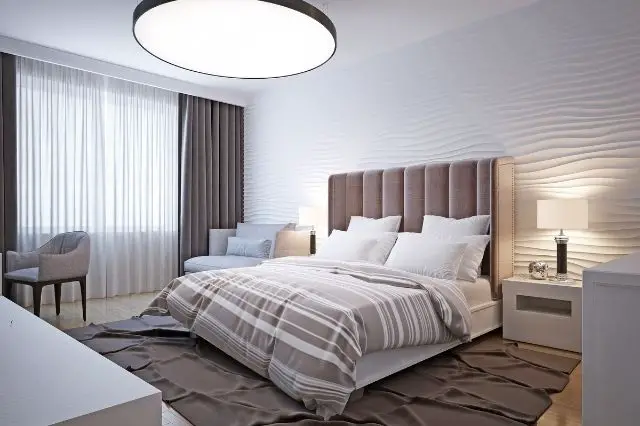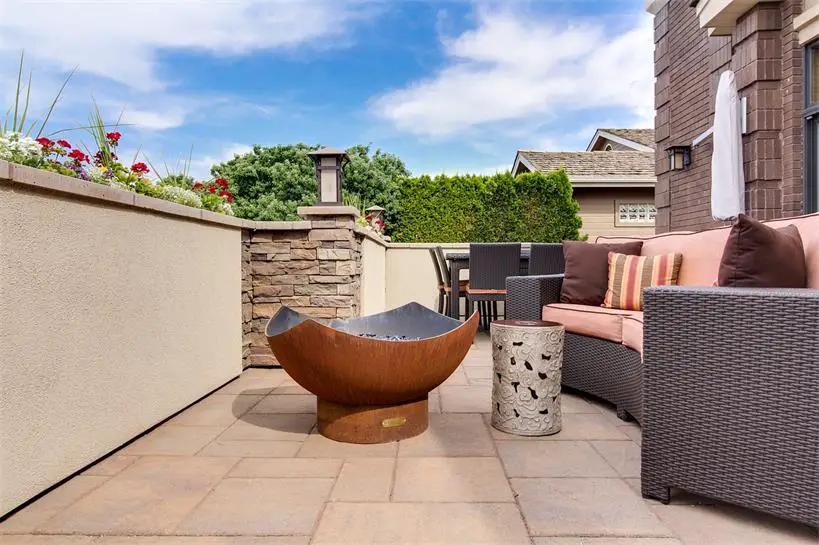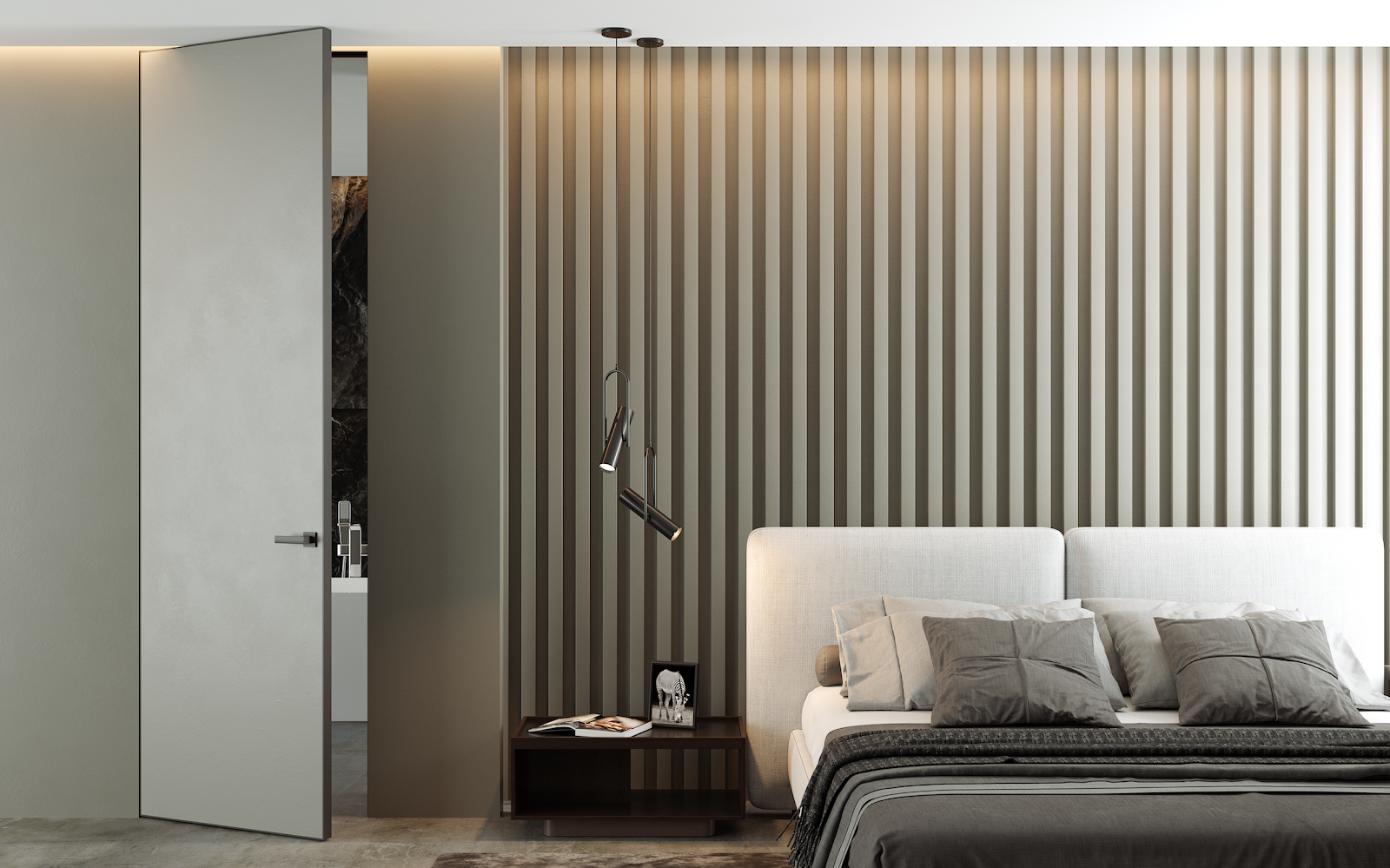Home Improvement
4 Ways to Beautify Your Small Bedroom

Searching for ways how to beautify your bedroom? Then you have come to the right place.
Your bedroom is your territory, and it is that place where you spend time relaxing and rejuvenating yourself after a tiresome day. And this fact makes it clear and the reason is evident why you must beautify your bedroom and give it a look that you prefer. A perfect bedroom will give you comfort and will help you in relaxing in the best way. Plenty of things matter in the bedroom, and it’s crucial for you to change it for your betterment.
Since your bedroom is the main part of your house, it becomes an integral part of your life too. Its vibe can be a major reason for your mood and will influence your day-to-day life.
Having a well-decorated room leaves a direct impact on you and, in fact, reflects much about your personality too! Some people tend to ignore these things. But you must know that your bedroom is the place that reflects you as a whole and must not depict any kind of negative vibe.
A small bedroom, in particular, is much more difficult to decorate! Are you wondering why? Well, it’s because a small bedroom is contradicted with the space and you need to make the right choices in the perfect manner in order to make it look wonderful. And this can be entirely possible if you follow our little ways mentioned below!
So, without any further delay, let’s check out what we have in store for you below!
1. Choose the Right Bed
The first thing that you need to think about is your bed. Your bed steals all the attention, so it is very important to invest in your bed and, of course, the perfect size.
Choosing the right size for your bed will ensure that your room has enough space and you are able to put in other pieces of furniture in your room. If you’ve got an old bed and don’t wish to invest in something new, you can easily revamp your bed!
And when it comes to revamping, you don’t have to do it on your own! Simply speaking to IKEA hackers and taking help from them will do your job just fine!
2. Improvise Your Ceiling
If you want to spice up your small bedroom, improvising your ceiling is the perfect decision. Try to paint the ceiling the same color as your walls. If you want to bring all the attention to your ceiling, then you can always hang a ceiling medallion.
Make sure to contrast the chandelier with the wall color. You can also decide to add some moldings along with the chandelier to add an extra touch to the look of your ceiling. If you don’t like moldings, you can also try out painting stripes on the ceiling to make your ceiling look modern and unique.
But whatever you do, make sure you keep it as minimal as possible!
3. Bring in Green Vibes
Greens not only bring in a great vibe but also makes your small bedroom look spacious and complement every other piece of furniture you have in your room.
Plus, you cannot refrain from saying that nothing else adds more comfort to the eyes than adding plants in the bedroom. Furthermore, adding plants in the bedroom will also enhance your mood as well as help in reducing fatigue.
Many houseplants even absorb the toxic substances and freshen the air in the bedroom, which will help in better sleep. Plants also increase the oxygen level in the air and absorb carbon dioxide.
The plants that you keep are Snake plants, rubber tree plants, spider plants, Gardenia, English Ivy, and many other plants that will help beautify your bedroom as well will be good for your health.
4. Other Pieces of Furniture
Make sure to choose the other pieces of furniture for your small bedroom correctly. If you get too much-unwanted furniture for your bedroom, it will destroy the look of your small bedroom as well as take up a lot of space in your bedroom. So, you can keep a small wardrobe, add a chic mirror, put in a dresser, and be sure this is going to enhance the look of your small bedroom.
Final Thoughts
When you have a large space, there is a lot you can do! But when it comes to a small space, you have to play it smartly! And with our little tips given above, you are sure to ace the look of your room massively!
Home Improvement
Finding the Right Paver Patio Contractor: What You Need to Know


Why Hire a Paver Patio Contractor?
When it comes to installing a paver patio, hiring a skilled contractor can make all the difference. A paver patio contractor specializes in designing and constructing patios using paver stones, ensuring that the final result is both visually appealing and durable.
In this article, we’ll explore the benefits of working with a professional contractor, what to look for when hiring one, and how to ensure a successful patio installation.
Benefits of Hiring a Professional Paver Patio Contractor
Choosing to work with a professional paver patio contractor offers several advantages:
Expertise and Experience
Professional contractors bring years of experience and expertise to your project. They understand the nuances of paver installation, from site preparation to layout design, ensuring that your patio is built to last.
Access to Quality Materials
Contractors have access to high-quality paver materials and can recommend the best options for your specific needs. They often work with trusted suppliers to ensure that the materials used are durable and aesthetically pleasing.
Efficient Installation
With a professional contractor, the installation process is streamlined and efficient. They have the tools and skills required to complete the project quickly while maintaining high standards of workmanship.
Design Expertise
Contractors can provide valuable design advice and help you choose the right paver patterns, colors, and layouts. Their expertise ensures that your patio complements your home and landscape while meeting your functional requirements.
How to Choose the Right Paver Patio Contractor
Selecting the right contractor is crucial for a successful patio project. Here are some tips to help you find a reliable and skilled paver patio contractor:
Check Qualifications and Experience
Ensure that the contractor has the necessary qualifications and experience in paver patio installation. Look for a contractor with a proven track record of successful projects and positive client feedback.
Review Their Portfolio
Examine the contractor’s portfolio to see examples of their previous work. This will give you an idea of their style, quality, and ability to handle projects similar to yours.
Read Customer Reviews
Customer reviews and testimonials provide insights into the contractor’s reliability and workmanship. Look for reviews on independent platforms and ask for references from past clients.
Verify Licensing and Insurance
Make sure the contractor is properly licensed and insured. This protects you from potential liabilities and ensures that the contractor meets industry standards.
Obtain Detailed Estimates
Request detailed written estimates from multiple contractors. Compare the costs, materials, and scope of work to ensure that you are getting a fair price and understanding what is included in the project.
The Paver Patio Installation Process
Understanding the typical steps involved in paver patio installation can help you prepare for the project:
Initial Consultation
The process begins with an initial consultation where the contractor discusses your vision, requirements, and budget. They will assess the site and provide recommendations based on your preferences.
Design and Planning
Next, the contractor will create a detailed design plan, including paver patterns, colors, and layout. They will present this plan to you for approval before proceeding with the installation.
Site Preparation
The contractor will prepare the site by clearing the area, excavating, and ensuring proper drainage. A well-prepared site is essential for a stable and long-lasting patio.
Base Installation
A solid base is crucial for the durability of the paver patio. The contractor will install a gravel or sand base and ensure it is compacted properly before laying the pavers.
Paver Installation
The pavers are then installed according to the design plan. The contractor will arrange the pavers, ensuring proper alignment and spacing, and then secure them in place.
Finishing Touches
After the pavers are installed, the contractor will add finishing touches such as joint sand and sealing. They will clean the area and make any necessary adjustments to ensure a high-quality finish.
Common Issues and How to Address Them
While paver patios are generally durable, some issues may arise. Here’s how to address common problems:
Settling or Shifting
If pavers settle or shift over time, it may be due to inadequate base preparation. Ensure proper installation and address any settling issues promptly to maintain a level surface.
Weed Growth
Weeds can grow between pavers if the joint sand is not properly maintained. Regularly sweep the patio and use weed control measures to prevent growth.
Stains and Discoloration
Stains or discoloration can occur due to spills or environmental factors. Clean the patio regularly and use appropriate sealers to protect the pavers and maintain their appearance.
Conclusion
Hiring the right paver patio contractor is essential for a successful patio project. By carefully selecting a skilled professional, you ensure that your patio is designed and installed to meet your expectations and enhance your outdoor space.
With the right contractor, you can enjoy a beautiful, durable paver patio that adds value and charm to your home.
Home Improvement
The Ultimate Guide to Furnace Maintenance


A well-maintained furnace is essential for ensuring your home stays warm and comfortable throughout the colder months. Regular furnace maintenance not only extends the life of your heating system but also ensures it operates efficiently, saving you money on energy bills and reducing the risk of breakdowns.
In this guide, we’ll cover everything you need to know about furnace maintenance, from routine tasks you can do yourself to the importance of professional inspections.
Why Furnace Maintenance Matters
Furnace maintenance is critical for several reasons:
Improved Efficiency
A clean and well-tuned furnace operates more efficiently, using less energy to heat your home. This not only lowers your utility bills but also reduces your carbon footprint.
Enhanced Safety
Furnaces that are not properly maintained can pose safety risks, such as carbon monoxide leaks or even fires. Regular inspections can identify and address potential hazards before they become serious problems.
Extended Lifespan
Like any mechanical system, a furnace that receives regular care will last longer. Routine maintenance helps prevent excessive wear and tear, reducing the likelihood of premature breakdowns and the need for costly replacements.
Reliable Performance
Regular maintenance ensures your furnace is ready to perform when you need it most, minimizing the risk of unexpected failures during the coldest months of the year.
DIY Furnace Maintenance Tasks
While some furnace maintenance tasks should be left to professionals, there are several routine tasks that homeowners can do to keep their systems in good shape:
Replace the Air Filter
One of the most important maintenance tasks is regularly replacing the air filter. A dirty filter restricts airflow, forcing your furnace to work harder and reducing efficiency. Aim to replace the filter every 1-3 months, depending on usage and the type of filter.
Check the Thermostat
Ensure your thermostat is functioning correctly by testing it before the heating season begins. If you have an older thermostat, consider upgrading to a programmable or smart thermostat to improve energy efficiency.
Inspect the Vents
Walk through your home and check that all vents and registers are open and unobstructed. Blocked vents can cause uneven heating and put extra strain on your furnace.
Clean Around the Furnace
Keep the area around your furnace clear of dust, debris, and flammable materials. A clean environment reduces the risk of fire and ensures proper airflow to the system.
Check the Flame
If you have a gas furnace, check the pilot light or burner flame. The flame should be a steady blue color. A yellow or flickering flame could indicate a problem with the burner or a carbon monoxide issue, which requires immediate professional attention.
The Importance of Professional Furnace Maintenance
While DIY tasks are important, scheduling professional furnace maintenance at least once a year is crucial for keeping your system in top condition. Here’s what to expect during a professional furnace tune-up:
Comprehensive Inspection
A professional technician will perform a thorough inspection of your furnace, checking for signs of wear, corrosion, and potential issues with components such as the heat exchanger, blower motor, and electrical connections.
System Cleaning
The technician will clean various parts of the furnace, including the burners, blower, and heat exchanger, to ensure optimal performance and efficiency.
Lubrication
Moving parts, such as the blower motor, may require lubrication to reduce friction and prevent wear. This helps your furnace run smoothly and quietly.
Safety Checks
Safety is a top priority during a professional tune-up. The technician will check for gas leaks, carbon monoxide emissions, and ensure the proper operation of safety controls.
Performance Testing
After completing the inspection and cleaning, the technician will test the furnace’s performance to ensure it is heating your home effectively and efficiently. This includes checking the system’s airflow, thermostat calibration, and overall operation.
When to Schedule Furnace Maintenance
The best time to schedule furnace maintenance is in the fall, before the heating season begins. This ensures your furnace is in peak condition when you need it most. However, if you haven’t had your furnace serviced in over a year, it’s never too late to schedule a tune-up.
Additionally, if you notice any of the following signs, you should contact a professional for maintenance or repairs immediately:
- Unusual noises such as banging, rattling, or squealing.
- Inconsistent heating or cold spots in your home.
- An unexplained increase in your energy bills.
- A yellow or flickering pilot light or burner flame.
- Frequent cycling on and off of the furnace.
The Cost-Benefit of Regular Furnace Maintenance
Some homeowners may be tempted to skip annual maintenance to save money, but this can be a costly mistake in the long run. Here’s why regular furnace maintenance is a smart financial investment:
Lower Energy Bills
As mentioned earlier, a well-maintained furnace operates more efficiently, which translates to lower energy consumption and reduced utility bills.
Avoid Costly Repairs
Routine maintenance helps catch small issues before they become major problems, reducing the likelihood of expensive emergency repairs.
Extend Furnace Lifespan
By preventing excessive wear and tear, regular maintenance can add years to the life of your furnace, delaying the need for a costly replacement.
Maintain Manufacturer’s Warranty
Many furnace manufacturers require proof of annual maintenance to keep the warranty valid. Skipping maintenance could void your warranty, leaving you responsible for the full cost of any repairs or replacements.
Conclusion
Furnace maintenance is an essential part of homeownership that can’t be overlooked. By performing regular DIY tasks and scheduling professional tune-ups, you can ensure your furnace runs efficiently, safely, and reliably for years to come.
Don’t wait until something goes wrong—schedule your furnace maintenance today and enjoy peace of mind all winter long.
Home Improvement
Transform Your Home with Contemporary Doors Interior: A Modern Aesthetic


Choosing contemporary doors interior is a vital aspect of modern home design, offering both functionality and a stylish touch. These doors are more than just functional elements; they can significantly enhance the look and feel of your living spaces.
In this guide, we will explore different types of contemporary interior doors, their benefits, and what to consider when selecting the perfect doors for your home. We’ll also highlight TrioDoors door stores in Toronto, a leading provider of high-quality interior doors.
Exploring Types of Contemporary Interior Doors
Contemporary interior doors come in a wide range of styles and materials. Here’s a look at some of the most popular options:
- Panel Doors
- Modern Twist: Traditional panel doors updated with clean lines and modern materials.
- Variety of Configurations: Available in multiple panel configurations, such as two, four, or six panels.
- French Doors
- Elegance and Light: Glass panels allow for the flow of natural light, enhancing the sense of space.
- Contemporary Glass Options: Choose from frosted, tinted, or clear glass for a modern touch.
- Sliding Doors
- Space-Saving: Slide along a track, perfect for areas where space is limited.
- Modern Aesthetic: Commonly used in modern homes for closets, bathrooms, and as room dividers.
- Pocket Doors
- Hidden Design: Slide into the wall cavity, making them virtually invisible when open.
- Ideal for Small Spaces: Great for rooms where a swinging door would be impractical.
- Barn Doors
- Rustic Meets Modern: Mounted on a sliding track, combining rustic charm with contemporary design.
- Statement Piece: Acts as both a functional door and a focal point in any room.
Key considerations when choosing contemporary interior doors
- Material Selection
- Wood: Classic look, customizable with various finishes and stains.
- MDF (Medium-Density Fiberboard): Smooth, easy to paint, and more affordable than solid wood.
- Glass: Perfect for allowing light flow while maintaining a modern aesthetic.
- Metal: Durable, often used in industrial or modern designs.
- Style and Design
- Consistency: Ensure the door style matches your home’s overall design theme.
- Functional Needs: Consider the specific purpose and requirements for each door.
- Size and Measurements
- Standard vs. Custom Sizes: While most doors come in standard sizes, custom options are available for unique spaces.
- Accurate Measurements: Proper measurement of the door frame is crucial to avoid fitting issues.
- Hardware and Accessories
- Handles and Knobs: Choose hardware that complements the door style and home decor.
- Hinges and Tracks: Ensure hardware is durable and functional for the chosen door type.
- Installation
- Professional Installation: For best results, consider professional installation.
- DIY-Friendly Options: Some doors are designed for easy DIY installation.
Selecting the right contemporary doors interior is essential for achieving both functionality and a modern aesthetic in your home. From sleek flush doors to elegant French doors, the choices are vast and varied. When choosing interior doors, consider factors such as material, style, size, and installation requirements to ensure they meet your needs.
For quality and reliability, purchase your contemporary interior doors (https://triodoors.ca/interior-doors/) from reputable suppliers like TrioDoors door stores in Toronto. It offers a wide selection of high-quality doors that cater to various styles and budgets, ensuring you find the perfect doors for your home.
Enhance your living space today with the ideal contemporary doors interior!
-



 Captions3 years ago
Captions3 years ago341 Sexy Captions to Fire Up Your Instagram Pictures
-



 Captions3 years ago
Captions3 years ago311 Night Out Captions for Instagram and Your Crazy Night
-



 Captions3 years ago
Captions3 years ago245 Saree Captions for Instagram to Boost Your Selfies in Saree
-



 Captions3 years ago
Captions3 years ago256 Best Ethnic Wear Captions for Instagram on Traditional Dress
-



 Captions3 years ago
Captions3 years ago230 Blurred Picture Captions for Instagram
-



 Captions3 years ago
Captions3 years ago275 Deep Captions for Instagram to Express Your Thoughts
-



 Quotes3 years ago
Quotes3 years ago222 Nail Captions for Instagram to Showcase Your Fresh Manicure
-



 Captions3 years ago
Captions3 years ago211 Laughing Captions for Instagram | Laughter Is the Best Medicine







